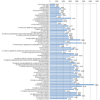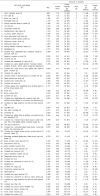Abstract
Purpose
The aim of study was to determine the effects of carbohydrate, fat, protein, and fiber contents on glycemic responses in a single food item or meal.
Methods
Glycemic responses were measured in 30 healthy young adults (17 males and 13 females) with various test foods, including rice, egg whites, bean sprouts, olive oil, noodles, prune, broccoli, Korean dishes, Western dishes, and salad dishes, etc. Test foods were designed to contain various carbohydrate, fat, protein, and fiber contents in single or mixed foods or dishes. After 12 hours of fasting, participants consumed test foods, and the glycemic response was measured for a subsequent 120 min (0, 15, 30, 60, 90, and 120 min). Three hundred and fifty three glycemic responses from 62 foods were collected. The incremental area under the curve (AUC) was calculated for each test food for each subject to examine glycemic responses. Statistical analysis was conducted to identify which macronutrient (carbohydrate, fat, protein and fiber) affected the AUC using a mixed model.
Figures and Tables
References
1. Song S, Choi H, Lee S, Park JM, Kim BR, Paik HY, Song Y. Establishing a table of glycemic index values for common Korean foods and an evaluation of the dietary glycemic index among the Korean adult population. Korean J Nutr. 2012; 45(1):80–93.

2. Sun L, Ranawana DV, Leow MK, Henry CJ. Effect of chicken, fat and vegetable on glycaemia and insulinaemia to a white rice-based meal in healthy adults. Eur J Nutr. 2014; 53(8):1719–1726.

3. Kim DY, Lee H, Choi EY, Lim H. Analysis and evaluation of glycemic indices and glycemic loads of frequently consumed carbohydrate-rich snacks according to variety and cooking method. J Korean Soc Food Sci Nutr. 2015; 44(1):14–23.

4. Ministry of Health and Welfare, Korea Centers for Disease Control and Prevention. Korea Health Statistics 2014: Korea National Health and Nutrition Examination Survey (KNHANES VI-2). Cheongju: Korea Centers for Disease Control and Prevention;2015.
5. Jenkins DJ, Wolever TM, Jenkins AL. Starchy foods and glycemic index. Diabetes Care. 1988; 11(2):149–159.

6. Riccardi G, Rivellese AA, Giacco R. Role of glycemic index and glycemic load in the healthy state, in prediabetes, and in diabetes. Am J Clin Nutr. 2008; 87(1):269S–274S.

8. Gaesser GA. Carbohydrate quantity and quality in relation to body mass index. J Am Diet Assoc. 2007; 107(10):1768–1780.

9. McKeown NM, Meigs JB, Liu S, Rogers G, Yoshida M, Saltzman E, Jacques PF. Dietary carbohydrates and cardiovascular disease risk factors in the Framingham offspring cohort. J Am Coll Nutr. 2009; 28(2):150–158.

10. Liu S, Willett WC, Stampfer MJ, Hu FB, Franz M, Sampson L, Hennekens CH, Manson JE. A prospective study of dietary glycemic load, carbohydrate intake, and risk of coronary heart disease in US women. Am J Clin Nutr. 2000; 71(6):1455–1461.

11. Denova-Gutiérrez E, Huitrón-Bravo G, Talavera JO, Castañón S, Gallegos-Carrillo K, Flores Y, Salmerón J. Dietary glycemic index, dietary glycemic load, blood lipids, and coronary heart disease. J Nutr Metab. 2010; 2010:170680.

12. Schulze MB, Liu S, Rimm EB, Manson JE, Willett WC, Hu FB. Glycemic index, glycemic load, and dietary fiber intake and incidence of type 2 diabetes in younger and middle-aged women. Am J Clin Nutr. 2004; 80(2):348–356.

13. Barclay AW, Petocz P, McMillan-Price J, Flood VM, Prvan T, Mitchell P, Brand-Miller JC. Glycemic index, glycemic load, and chronic disease risk--a meta-analysis of observational studies. Am J Clin Nutr. 2008; 87(3):627–637.

14. Du H, van der A DL, van Bakel MM, van der Kallen CJ, Blaak EE, van Greevenbroek MM, Jansen EH, Nijpels G, Stehouwer CD, Dekker JM, Feskens EJ. Glycemic index and glycemic load in relation to food and nutrient intake and metabolic risk factors in a Dutch population. Am J Clin Nutr. 2008; 87(3):655–661.

15. Murakami K, Sasaki S, Takahashi Y, Okubo H, Hirota N, Notsu A, Fukui M, Date C. Reproducibility and relative validity of dietary glycaemic index and load assessed with a selfadministered diet-history questionnaire in Japanese adults. Br J Nutr. 2008; 99(3):639–648.

16. Hätönen KA, Virtamo J, Eriksson JG, Sinkko HK, Sundvall JE, Valsta LM. Protein and fat modify the glycaemic and insulinaemic responses to a mashed potato-based meal. Br J Nutr. 2011; 106(2):248–253.

17. Brouns F, Bjorck I, Frayn KN, Gibbs AL, Lang V, Slama G, Wolever TM. Glycaemic index methodology. Nutr Res Rev. 2005; 18(1):145–171.

18. Wolever TM, Jenkins DJ. The use of the glycemic index in predicting the blood glucose response to mixed meals. Am J Clin Nutr. 1986; 43(1):167–172.
19. Wolever TM, Yang M, Zeng XY, Atkinson F, Brand-Miller JC. Food glycemic index, as given in glycemic index tables, is a significant determinant of glycemic responses elicited by composite breakfast meals. Am J Clin Nutr. 2006; 83(6):1306–1312.

20. Gannon MC, Nuttall FQ, Westphal SA, Seaquist ER. The effect of fat and carbohydrate on plasma glucose, insulin, C-peptide, and triglycerides in normal male subjects. J Am Coll Nutr. 1993; 12(1):36–41.

21. Ercan N, Gannon MC, Nuttall FQ. Effect of added fat on the plasma glucose and insulin response to ingested potato given in various combinations as two meals in normal individuals. Diabetes Care. 1994; 17(12):1453–1459.

22. Munoz JM, Sandstead HH, Jacob RA, Johnson L, Mako ME. Effects of dietary fiber on glucose tolerance of normal men. Diabetes. 1979; 28(5):496–502.

23. Gatenby SJ, Ellis PR, Morgan LM, Judd PA. Effect of partially depolymerized guar gum on acute metabolic variables in patients with non-insulin-dependent diabetes. Diabet Med. 1996; 13(4):358–364.

24. Quek R, Bi X, Henry CJ. Impact of protein-rich meals on glycaemic response of rice. Br J Nutr. 2016; 115(7):1194–1201.





 PDF
PDF ePub
ePub Citation
Citation Print
Print






 XML Download
XML Download